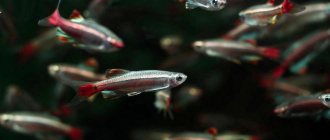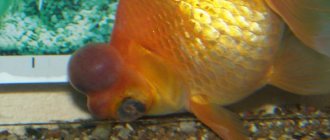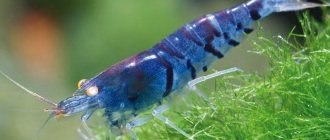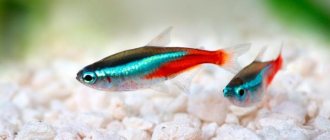10/07/2019Crustaceans0
The aquarium shrimp is a crustacean animal that has enormous endurance. Thanks to its beauty and sophistication, it is gaining popularity.
- 1 General description of shrimp and natural habitats
- 2 Mr. Tail recommends: variety of species
- 3 Basics of aquarium keeping
- 4 Compatibility
- 5 Feeding
- 6 Breeding
- 7 Pros and cons of keeping shrimp in aquariums
Description
Shrimp is considered the most common crustacean; it is used as food by both representatives of the animal world and humans.
Seas, oceans, and fresh water reservoirs are excellent habitats and breeding grounds for shrimp. They are especially valued for their taste and are considered a delicacy, which is why they are used in cooking.
The shrimp is called an unusual, mysterious inhabitant of the aquatic environment.
Contains a large amount of protein and calcium, therefore it is a low-calorie food.
Life span is from one to five and a half years.
How to store
The manufacturer indicates shelf life on the back of the package. They are the main reference point for organizing home storage. The general requirements are:
- chilled shrimp can be stored in the refrigerator on an ice bed for no more than 7 days from the date of catch;
- frozen - in the freezer for 12-24 months in accordance with the recommendations on the package;
- cooked - no more than 2 days in the refrigerator.
Important!
When purchasing a frozen product, defrosting is acceptable if you plan to cook it within the next 24 hours. If cooking is planned for a later date, the packaging must be immediately placed in the freezer. With repeated defrosting, seafood will lose its juiciness and taste.
- ⇐ How to choose the right salmon steak
- |
- Fish medallions in a frying pan with spicy rice ⇒
Kinds
There are more than a hundred different commercial species that are used as a favorite food by humans. For these purposes, special shrimp farms are equipped.
For home breeding in aquariums, there are varieties that successfully live and develop in artificial conditions.
They are classified into freshwater, cold-water, warm-water and salt-water:
- Russia, Australian waters, South Asia are the habitats of freshwater shrimp.
- The North, Baltic, Barents Sea, Greenland, and Canada are inhabited by cold-water shrimp.
- The southern coast is teeming with warm-water shellfish.
- Brackish shrimp are common in salt waters.
- The South American coast, the Black and Mediterranean Seas are the habitat of Chilean crustaceans.
- The king prawn is found in the Atlantic Ocean.
Appearance
Depending on the species, shrimp vary in color, size and behavior. The body of the arthropod is elongated, flattened in the lateral part. Consists of a cephalothorax and abdomen, the predominant colors are gray-green, pink, blue, with stripes or spots.
The animal grows from 1 to 32 cm in size.
The organ of vision, the eye, consists of a plurality of facets, the number of which increases from year to year. The arthropod perfectly sees close objects due to mosaic vision. It is the visual organs that produce a special hormone that is involved in regulating processes:
- Changes body color.
- Participate in the growth of the individual.
- Affects the number of molts.
- Determines the amount and location of pigment.
- promotes calcium accumulation and metabolism.
The organ of touch looks like the anterior antennae of the antennae. There are five pairs of legs on the abdomen that help in swimming. On these legs, pleopods, the female bears her offspring.
The shrimp moves and thereby washes and cleans its eggs. With the help of flexion movements of the abdomen, the arthropod can quickly move backwards.
The jaw limbs help collect food and bring it to the mouth.
The front pairs of legs of the shrimp are presented in the form of claws. With their help, the shrimp can defend itself and, in case of danger, defend itself with their help. The claw can grab larger prey. The claws of males are much more developed than those of females. The left and right legs can move in different directions at the same time.
The shrimp breathes using gills hidden in its shell. A large blade in the thoracic region helps the water pass through the gills and release oxygen.
Moisture content
Glazed shrimp contains moisture, the presence of which is determined after removing the glaze. If there is not enough moisture, the shrimp will taste dry. Excess moisture causes the shrimp to swell and become soft and watery in taste.
According to experts, an overestimated indicator of the mass fraction of moisture may be a sign of soaking the shrimp, that is, a deliberate increase in their mass.
It is possible that the increased moisture content is due to additional processing of raw materials with solutions containing moisture-retaining additives. The main purpose of such processing is to increase product yield. Of course, the shrimp taste more juicy, but with such processing, chemical components are introduced into the shrimp that do not improve the nutritional and biological value of the product
– comments our expert Lyubov Abramova, Deputy Head of the Department for Quality of Fish Food Products of the Federal State Budgetary Institution “VNIRO”, Doctor of Technical Sciences, Professor.
According to TR CU 040/2016, the mass fraction of moisture in shrimp should be no more than 80% of the total weight.
Of the 25 brands, experts found the most “watery” shrimp: Billa (86.7%), “Bay of Plenty” - peeled (86.3%) and “New Ocean” (82.2%).
2021 Study
In an earlier study, Bay of Plenty shrimp were found to be high in moisture, while Fine Life shrimp were low. However, the current test showed that the manufacturers have worked on the mistakes and the products of both brands have normal humidity.
Habitat
The habitat of shrimp is seas and oceans; arthropods are ubiquitous.
The young crustacean feeds exclusively on the purest plankton, which makes its meat a particularly valuable and high-quality product.
Scavenger shrimp feed on any organic debris. Favorite delicacies include plankton, juicy algae leaves, soil particles, and young fish. The organs responsible for smell and touch, in the form of antennae, help the shrimp search for food.
Some individuals search for vegetation in the ground, others at the bottom.
Due to their low vision, arthropods see practically nothing in the water at a long distance.
The sense of smell helps to find food and hunt. With the help of developed jaws and mandibles, the shrimp grinds and crushes the prey; this process can take 2-3 hours.
As homemade food, shrimp are fed with a prepared mixture or boiled vegetables and fresh fruits. The shrimp eats leftover food from aquarium fish.
Taste, color, smell
Roskachestvo experts traditionally conducted shrimp tasting “blindly,” that is, without announcing the names of trademarks. In appearance, the shrimp should be whole, uniform in size, curved. Color – white, with a pinkish or pinkish-orange cover.
To whom nutritionists recommend including shrimp in their diet, read HERE
There were practically no comments on the appearance of the shrimp, with the exception of the different sizes of shrimp of the “First thing” brand and broken shrimp in the Billa and Kaluri packages.
The consistency of the studied shrimp did not cause any complaints from experts. For most brands, the product met the requirements - the shrimp meat is dense, juicy (a slight dryness is allowed).
However, the taste and smell of some brands' products left much to be desired. Thus, Globster and Vici (unpeeled) shrimp turned out to have an unpleasant taste and smell.
– The presence of an unpleasant taste and smell indicates that the storage conditions of the products were not observed in the sales area. Boiled-frozen shrimp should be stored at a temperature from –25 to –18 °C. Violation of these conditions affects organoleptic characteristics. Signs of violations of temperature storage: the presence of an unpleasant odor, a dried, rusty surface of the shell and/or whitish spots on the surface of the shell,” comments Andrey Martsinkevich, deputy head of the laboratory of the Federal State Budgetary Institution “NTsBRP”.
Read about what organoleptics are and how products are tested HERE and HERE
Reproduction
All shrimp are hermaphrodites, i.e. bisexual. The formation of male and female glands occurs over different periods of time. Sexual maturity of a young shrimp begins with becoming a male and only after three years does it become a female. Eggs at the formation stage look like a yellow-green mass.
Individuals mate very quickly, eggs soon appear, which subsequently become larvae. The process of larval formation takes from 10 days to a month.
The larvae are not capable of independently searching for food and lead a sedentary lifestyle.
Natural enemies
A large number of shrimp die in the larval stage. Arthropods are the favorite food of whale sharks, whales, and other planktivores. Shellfish, seabirds, fish, and some mammals also eat shrimp.
She is completely unarmed. The only way to escape from the enemy is to escape; she can hide in a thicket of algae.
Another feature is the possibility of camouflage. The shrimp imitate the color of the bottom and adapt the color of quinine to its surroundings. Animals are caught on an industrial scale. Producers extract from 2 to 3 million tons of arthropods annually.
Population
Due to high fertility and the ability to self-regulate, the shrimp maintains its population at a sustainable level. Even natural enemies, low larval survival rates, and industrial fishing do not cause much damage to the population.
The following features are distinguished:
- When there is a significant reduction in the number of arthropods, individuals begin to reproduce more actively.
- If there is a shortage of food, then females give birth to much smaller offspring.
- The highest quality are arthropods grown in clean, cold water and in a natural environment.
Tiger shrimp is large in size, unusual in color, and has a high meat content. It grows up to 30-40 cm long, green in color, with noticeable dark stripes throughout the body. They are grown on special farms, which makes it possible for suppliers and manufacturers to supply stores and supermarkets with goods. There you can find both fresh frozen shrimp and chilled, boiled, frozen or canned ones.
The northern shrimp is called chilim, it is small in size, up to 6 cm. However, it tastes simply amazing; you can only buy it boiled - frozen.
Red Crystal Shrimp
Red Crystal Shrimp is an artificially bred form. To obtain its rich color, consisting of alternating white and red stripes, breeders from Japan spent more than one year selecting and crossing the best representatives. Modern Crystals are bright, contrasting, eye-catching shrimp. They grow about 2-4 cm.
The red crystal belongs to the genus Caridina. They are quite demanding in terms of keeping conditions and are not recommended for beginner aquarists. Crystals need slightly acidic soft water with a temperature of +23...+25 degrees.
Benefit and harm
By including shrimp in your diet, a person gets:
- A protein product that improves the body's protective functions.
- Reducing the development of heart disease.
- The quality of hair, skin, and nails improves.
- Due to the high calcium content, hormonal levels are balanced.
- Due to the high content of selenium and zinc, shrimp meat has a beneficial effect on male potency and increases testosterone production.
Excessive use of the product in large quantities can cause allergies. It can be especially allergenic for children's bodies. Due to the high cholesterol content, a person should limit himself in eating shrimp. It is necessary to use high-quality and fresh product. It is very easy to get poisoned by expired shrimp. Fever, vomiting, nausea and diarrhea may occur. In rare cases, hospitalization may be necessary.
Preparation
The shrimp is small, large in size, bright pink and earthy brown in color, soft, buttery, sweet and elastic, crispy and almost tasteless.
Shrimp can be boiled, fried and grilled. There are many recipes that include shrimp meat.
Before cooking, shrimp can be marinated by mixing olive oil, garlic and various spices such as oregano, thyme, Italian spice mix, pepper, lemon juice and minced garlic.
Defrost shrimp at room temperature without heating. This way, nutrients are not destroyed and the structure of the shrimp remains intact.
Arthropods are usually fried in hot oil.
Interesting Facts
- Some species grow up to 40 cm long.
- Can change gender during life.
- They are a nutritious low-calorie product. Recommended for use during a diet.
- Recognition and fame came to one Chinese artist after depicting shrimp on his canvases.
- Animals can exist both in the sea and in fresh water.
- The largest shrimp caught weighed more than half a kilogram.
- In ancient times, the Greek peoples ate shrimp.
- To cook, you need to boil the seafood for 3 minutes, but it will be safe for consumption and retain its beneficial substances.
- The heart is in the head.
- The animal can live up to 10-20 years.
- With the onset of night, the shrimp brightens, becomes translucent, and during the day it darkens and changes color.
- The name "king prawn" is a non-scientific species of arthropod. This is what people call her, calling all the great representatives of the royal family.
- Judaism prohibits the consumption of these animals for human food.
- Cold-water shrimp cannot be artificially grown; only the natural environment is suitable for its reproduction.
How much frosting should there be?
An important indicator for shrimp is the mass of glaze
The glaze helps preserve the presentation and freshness of shrimp during transportation and storage; therefore, if there is not enough glaze in the shrimp, then they may not only lose their presentation during transportation and storage, but also taste dry.
Read how to choose boiled-frozen shrimp HERE
.
Why shrimp are boiled immediately after catching, read HERE
.
At the same time, the more glaze, the less healthy food product the consumer receives by volume. In addition, sometimes manufacturers use glaze to “increase” the size of the shrimp or indicate the net weight of the shrimp, including the weight of the glaze (ice).
Until recently, the Unified Sanitary Requirements and Technical Regulations of the EAEU did not regulate the amount of glaze in shrimp. To protect the interests of the consumer, restrictions on the glaze content in shrimp were introduced in SanPiN 2.3.2-1078, and then in EAEU TR 040/2016. For peeled shrimp it should not exceed 7%, and for uncut shrimp - 14% of the total weight. However, manufacturers were assigned a transition period to the new requirements of the EAEU TR. Thus, they must bring their products into compliance with the new requirements before September 1, 2021.
Thus, today manufacturers who produce a product with an increased amount of glaze will not be considered violators. But from September 1, 2021, these inconsistencies will turn into violations of the law.
A number of manufacturers are already following glaze standards. In our study, the products of 13 brands met the increased requirements for the amount of glaze: “Ashana” (Kaluga region, uncut, 10.3% glaze, “by weight”), “Bay of Plenty” (royal uncut, 11.80% glaze), "Bay of Plenty" (royal, cleared 11.60%), "Moreslav" (uncut 5.70%), "New Ocean" (uncut, 6.8%), "First Thing" (uncut 5.40%), Agama (uncut, 13.40% glaze), Aro (uncut, 14.40% - error ± 1.2 permissible), Delight (not completely peeled, with a tail, 10.8%), Fine life (uncut, 8. 40%), Fish House (uncut, 8.40%), Globster (uncut, 14.40%), Kaluri (uncut, 7.10%).
In the products of 12 brands, the glaze layer did not meet these requirements, but until the end of the transition period this deviation is not officially a violation, however, these products will not be able to qualify for the Russian Quality Mark: “Bay of Plenty” (purified 16.30% of the glaze by total weight, – instead of 7%); “Every day” (uncut, 16.10%, - instead of 14%), “Tape” (cleaned 18.70%); Maguro (vannamei shrimp, not fully peeled, 23.90%); Maguro (northern wild shrimp 17.20%), “Ocean of taste” (uncut, 18.50%), Billa (peeled, 16.30%), Polar (northern, whole 23.50%), Polar (vannamei, whole 23.80%; Vici (refined 15.20%); Vici (royal whole, 20.40%), Embord (refined 13.40%)
2021 Study
The results of the study suggest that a lot of work has been done to improve product quality. If, after a study two years ago, shrimp of this brand were found to have such shortcomings as non-compliance with the advanced standard for glaze content and appearance, then this time the experts did not find these discrepancies.











